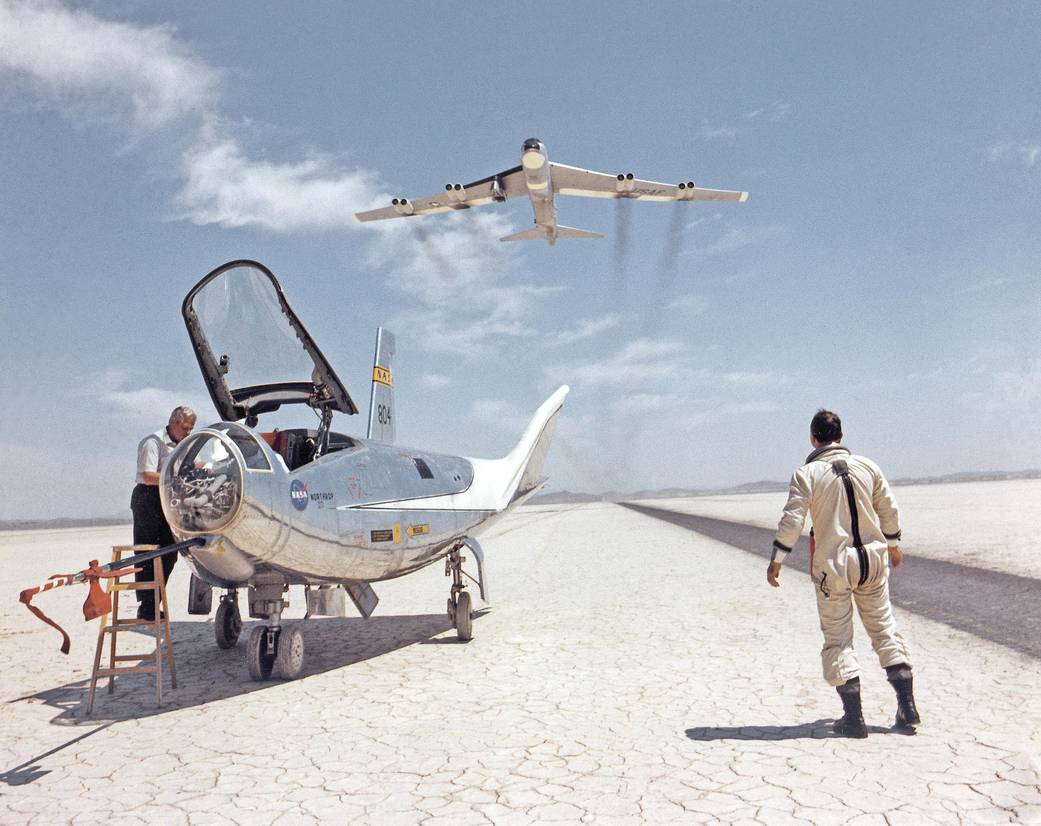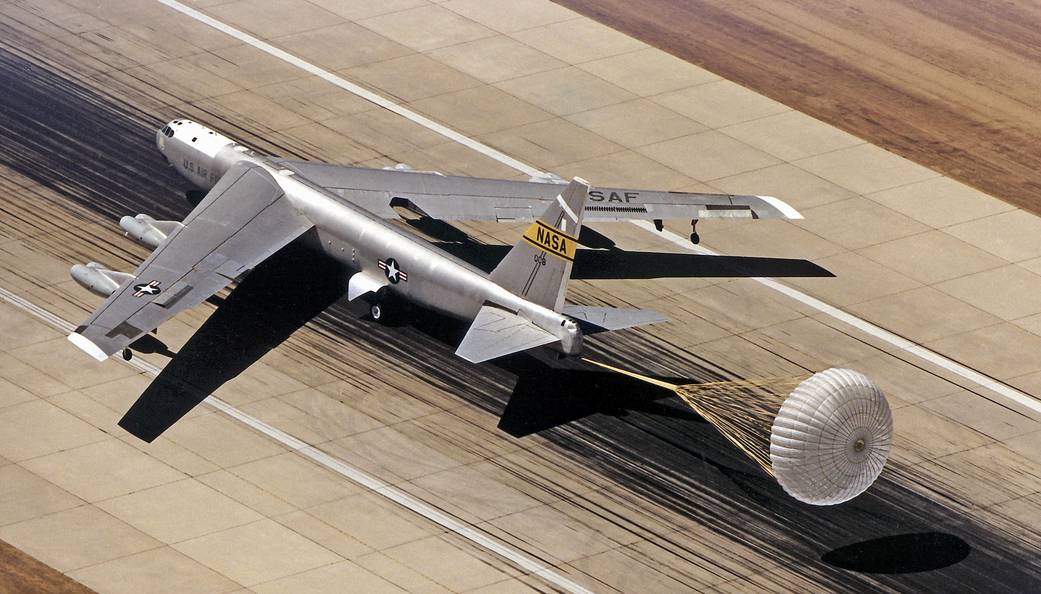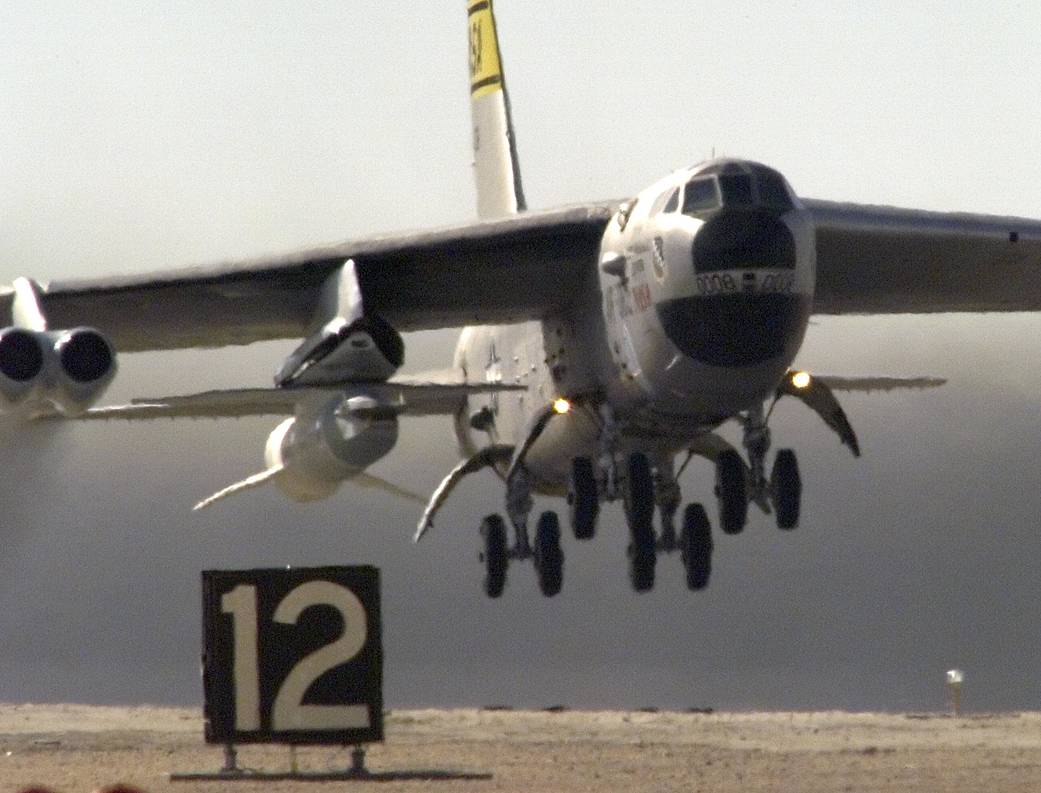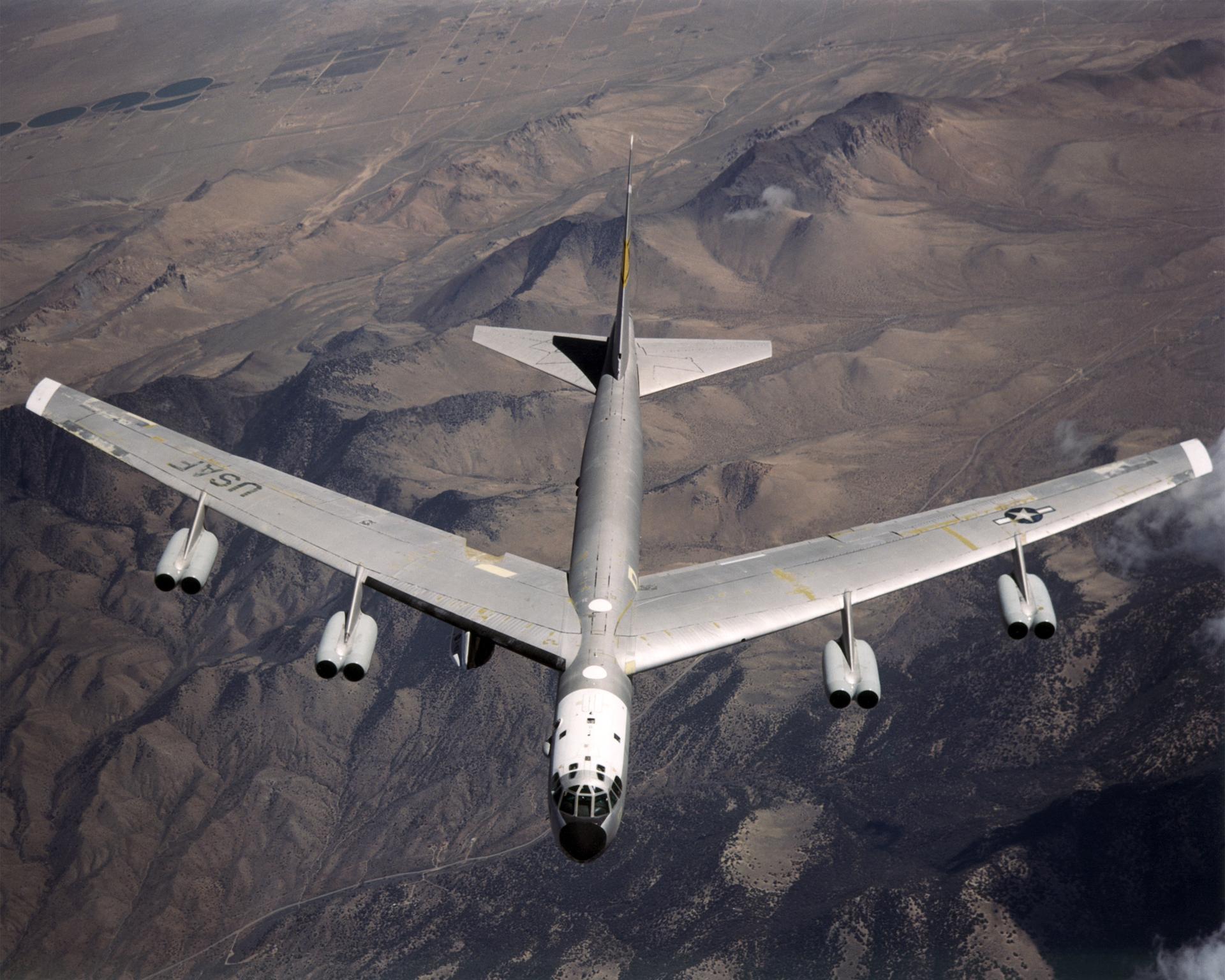B-52 Heavy-Lift Airborne Launch Aircraft
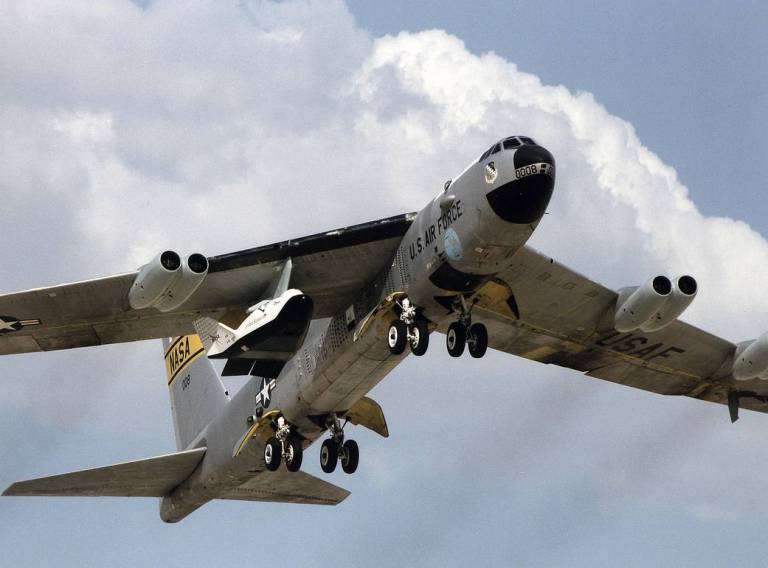
B-52B
NASA’s B-52B launch aircraft, operated by Dryden (now Armstrong) Flight Research Center, took part in some of the most significant aerospace projects in history. At the time of its retirement, the aircraft held the distinction of being both NASA’s oldest aircraft and the oldest B-52 in flying status. Despite this, it had logged the fewest flying hours (2,443.8) of any B-52 in operation, having been used solely as a research and launch platform for nearly 50 years.
The B-52B, with registration number 52-0008 and NASA tail number 008, rolled out of Boeing’s Seattle plant as an RB-52B and made its first flight on June 11, 1955. It was the 10th B-52 off the Boeing assembly line and initially served as a U.S. Air Force test aircraft before being assigned to support the X-15 research aircraft program at Dryden.
B-52B Missions
X-15 Program
NASA aircraft tail number (TN) 008 was one of two B-52s used to air-launch the three X-15 rocket-powered aircraft. It served as the launch aircraft for 140 of the program’s flights and participated in 159 total captive-carry and launch missions.
From June 1959 through October 1968, the X-15 program set world speed and altitude records of Mach 6.7 and 354,200 feet. The program contributed critical data to the development of Mercury, Gemini, Apollo, and space shuttle missions.
The other B-52 used in the program, TN 003, was retired in 1969 and placed on permanent display at the Pima Air & Space Museum in Tucson, Arizona.
Lifting Bodies
Between 1966 and 1975, B-52 TN 008 launched 127 of the 144 lifting body research flights. These vehicles generated lift from their body shape, and the addition of control surfaces allowed pilots to stabilize and guide them through atmospheric flight after reentry. The program proved that such aircraft could reenter from space and land safely.
Space Shuttle Program Support
Between 1977 and 1978 and again from 1983 and 1985, the aircraft supported the development of the space shuttle solid rocket booster parachute recovery system. From July to October 1990, it flew eight tests of a drag chute system designed to reduce landing distance and wear on orbiter tires and brakes.
Tests were conducted on lakebed and concrete runways at speeds ranging from 160 to 230 mph. The first operational use of the drag chute system occurred during space shuttle Endeavour’s first landing on May 16, 1992.
Miscellaneous Support
NASA TN 008 launched several remotely piloted research aircraft during the 1970s and ’80s, including the subscale F-15 spin research vehicle, the HiMAT (Highly Maneuverable Aircraft Technology) aircraft, and the DAST (Drones for Aerodynamic and Structural Testing) project, which examined flutter and aerodynamic load alleviation.
Beginning in 1979 and concluding in 1992, the aircraft supported U.S. Air Force tests to extend the operational life of the F-111 crew escape module’s parachute recovery system.
It also launched the first six commercially developed Pegasus rockets, designed by Orbital Sciences Corp. under Defense Advanced Research Projects Agency (DARPA) sponsorship. The first Pegasus launch from TN 008 took place on April 5, 1990, about 60 miles southwest of Monterey, California.
Tail number 008’s primary mission in later years was to support the X-38 Crew Return Vehicle program. Its first free-flight occurred in March 1998, and support continued until the project’s cancellation in 2001.
Hyper-X
In its final mission series, TN 008 launched NASA’s Hyper-X project, which tested scramjet propulsion. The first X-43A vehicle was lost on June 2, 2001, after aerodynamic forces exceeded the Pegasus-derived booster’s control limits.
The second X-43A launched successfully on March 27, 2004. Dropped from 40,000 feet, it achieved Mach 6.8 at around 95,000 feet. The third and final X-43A flight on Nov. 16, 2004, reached Mach 9.6.
Notably, TN 008’s first and final missions involved launching hypersonic vehicles—the X-15 in 1960 and the X-43A in 2004.
B-52B Retirement
NASA retired aircraft TN 008 on Dec. 17, 2004, in a joint NASA and U.S. Air Force ceremony. It was returned to the Air Force and placed on permanent public display near the north gate of Edwards Air Force Base, California.
B-52B Aircraft Modifications
Major structural modifications included a cutout in the right inboard wing flap to accommodate the vertical tail of the X-15 and later for Pegasus and Hyper-X vehicles. The aircraft’s flaps were permanently disabled due to this modification. Additional reinforcement was made to support heavy loads under the right wing.
Dryden engineers designed custom pylons for each vehicle, always mounted between the inboard engine pod and the fuselage. The same pylon used for the X-15 was repurposed for the X-43A, linking two hypersonic programs.
The aircraft also carried specialized instrumentation and, for the Hyper-X program, was outfitted with a second launch panel operator station.
B-52B Aircraft Specifications
- Engines: Eight Pratt & Whitney J-57-19 turbojets (12,000 pounds of thrust with water injection)
- Length: 156 feet
- Wingspan: 185 feet
- Top speed: 390 knots (448 mph)
- Max altitude: More than 50,000 feet
The heaviest load carried by TN 008 was the 53,100-pound X-15 No. 2 with external fuel tanks. It also carried the 47,772-pound shuttle recovery system and the 41,152-pound Pegasus rocket. To counteract asymmetrical loads, the crew transferred fuel between wings and anticipated dramatic roll reactions upon payload release.
B-52H
NASA acquired a B-52H from the U.S. Air Force in 2001 as a replacement for TN 008. Dryden built a new, modular pylon for it, capable of carrying up to 25,000 pounds.
The B-52H, serial number 61-0025, arrived at NASA on July 30, 2001, from Minot Air Force Base in North Dakota. Initially on loan, it was later transferred permanently to NASA.
Although intended to replace TN 008, it was returned to the Air Force in 2007 due to a lack of relevant projects under NASA’s revised aeronautics programs. The Air Force planned to use it as a ground training aid.
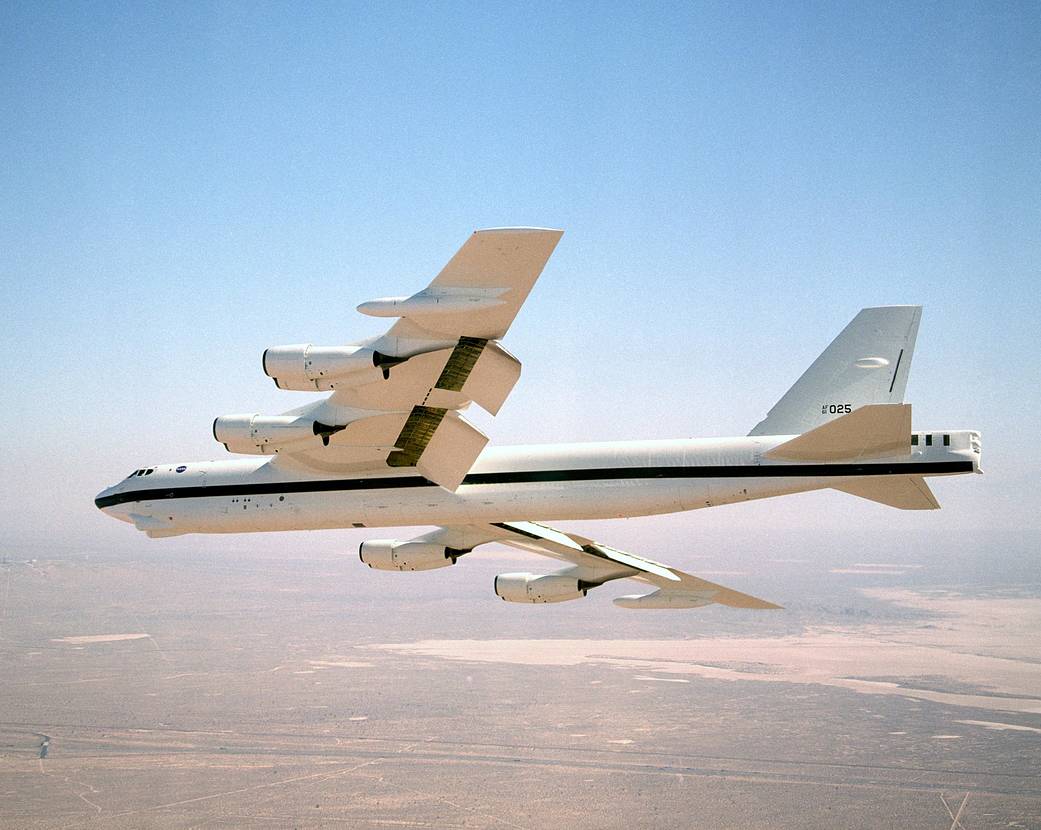
B-52H Aircraft Specifications
- Contractor: Boeing Military Airplane Co.
- Engines: Eight Pratt & Whitney TF33-P-3/103 turbofans
- Thrust: Up to 17,000 pounds per engine
- Length: 159 feet, 4 inches
- Height: 40 feet, 8 inches
- Wingspan: 185 feet
- Max speed: 650 mph (Mach 0.86)
- Ceiling: 50,000 feet
- Empty weight: Approx. 185,000 pounds



























